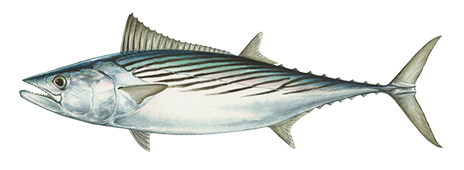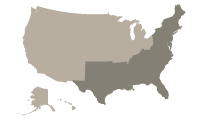
Atlantic Bonito
The Atlantic bonito is often confused with the skipjack or with other Atlantic Scombroid species.

Region
South, Northeast
Catch ease
Easy
Habitat
Ocean
How to identify an Atlantic Bonito
The bonitos have stripes on the back, not the belly. The first dorsal fin has 20-23 spines. The second dorsal fin consists of 13-18 rays followed by 7-10 finlets. The anal fin consists of 14-17 rays followed by 6-8 finlets. The caudal peduncle has a lateral keel on either side. As with all Scombroid fishes, there are also two smaller keels farther back, above and below the main keel. The Sarda species have no teeth on the tongue and no swim bladder. Also, the intestine is straight, rather than folded in the middle. There are a total of 16-23 gill rakers on the first gill arch. The back is steel blue or blue-green. The lower flanks and belly are silvery.This species is pelagic, schooling and migratory and feeds on smaller fishes and squids usually at or near the surface 15-20 miles offshore. A strong, fast swimmer, it is known to skip or leap out of the water when in search of prey.Where to catch Atlantic Bonito
The Atlantic bonito occurs in tropical and temperate waters of the Atlantic Ocean from Argentina to Nova Scotia and from South Africa to Norway. It is rare in the Caribbean Sea and Gulf of Mexico and is common in the Mediterranean and Black Seas. It is replaced in the Pacific by other Sarda species. The following list includes additional details on where to catch this fish:
| Baitfish Patches |
| Coastal Waters |
| Floating Foam and Debris |
| Night Fishing |
| Birds |
| Deep Shore Water |
| Merging Water |
| Reefs, Wrecks, and Shoals |
how to catch Atlantic Bonito
The best fishing methods include trolling, casting, jigging, or live bait fishing. Baits include small pelagic schooling fishes and squid as well as cut fish, strip baits, or any of a variety of artificial lures. The flesh is dark colored and held in low esteem by many. The following are fishing methods used to catch this fish:
Atlantic Bonito lures, tackle & bait
The following are lures, tackle or bait that can be used to catch this fish:
